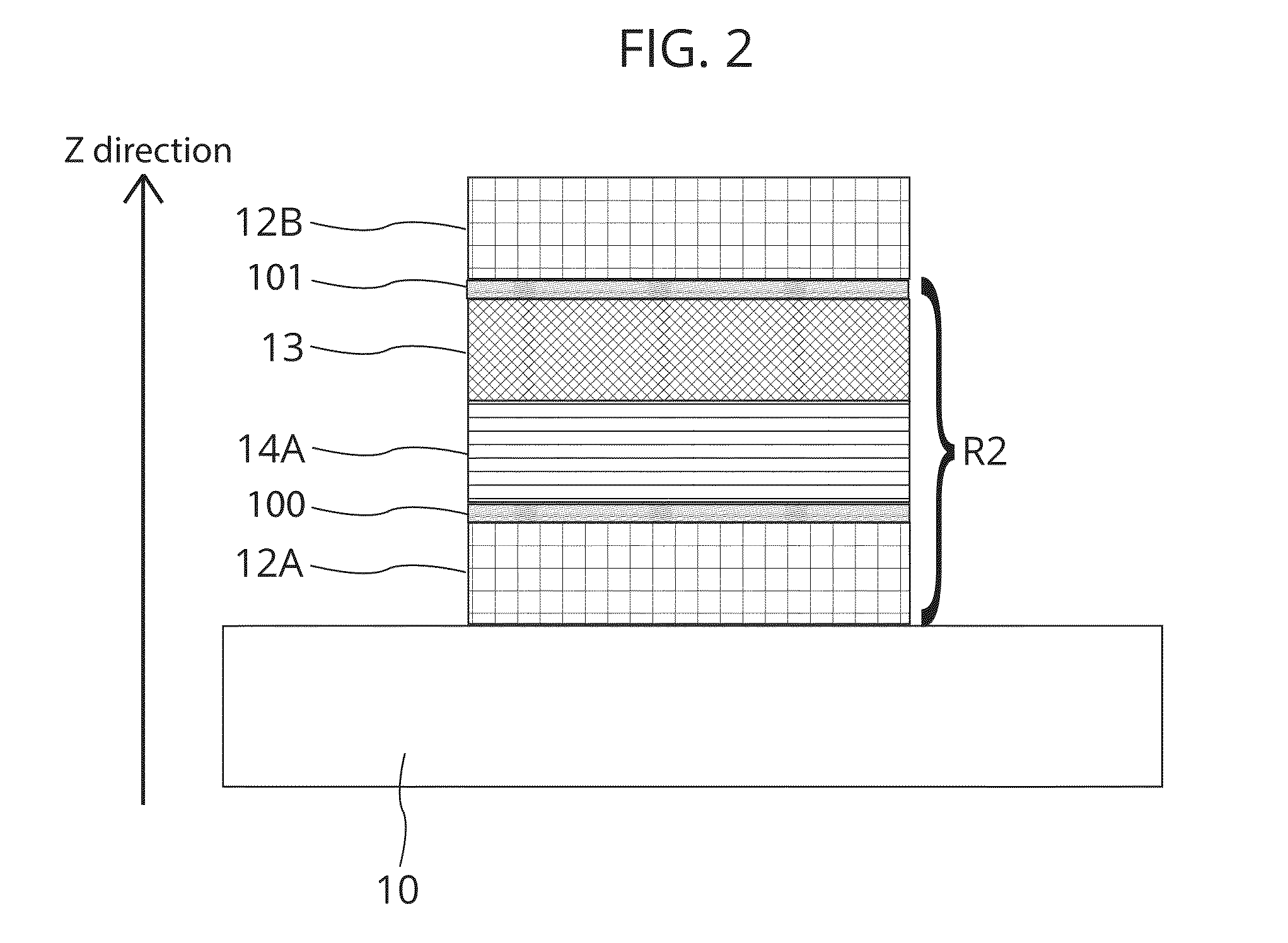Ferroelectric memory device and fabrication process thereof, and methods for operation thereof
a ferroelectric memory and fabrication process technology, applied in the field of memory devices and photonics, can solve the problems of ferroelectric materials, lithium niobate, and difficult to manufacture on the nano-scale properly, and achieve the effects of improving the efficiency of production and maintenance, reducing the cost of production, and improving the quality of production
- Summary
- Abstract
- Description
- Claims
- Application Information
AI Technical Summary
Benefits of technology
Problems solved by technology
Method used
Image
Examples
first embodiment
[0055]FIG. 1 shows the construction of a ferroelectric memory device according to the first embodiment of the present invention.
[0056]Going from bottom to top, the first embodiment consists of a substrate 10, a bottom electrode 12A, a Schottky modulating interlayer 100, a ferroelectric layer 13, a Schottky modulating interlayer 101, and a top electrode 12B. The present embodiment also contains a section of layers labeled R1, which can be repeated n times where n is any number from 0 to infinity.
[0057]The substrate layer 10 acts as a platform to grow the rest of the structure on top of. The substrate layer generally consist of undoped silicon, or N or P doped silicon. The substrate layer can also consist of an electronic layer containing transistors with a bit and word line to select single memory cells. In this case, the memory cell will sit above the transistors in such a way as to allow current and voltage to be sent to a single memory cell without disturbing the others. The subst...
second embodiment
[0120]FIG. 2 shows the construction of a ferroelectric memory device according to the second embodiment of the present invention.
[0121]Going from bottom to top, the second embodiment consists of a substrate 10, a bottom electrode 12A, a Schottky modulating interlayer 100, a semiconductor layer 14A, a ferroelectric layer 13, a Schottky modulating interlayer 101, and a top electrode 12B. The present embodiment also contains a section of layers labeled R2, which can be repeated n times where n is any number from 0 to infinity.
[0122]All of the layers, except for the semiconductor layer 14A, are exactly as described for the first embodiment. The names of the other layers have remained the same as in the first embodiment to show that they are identical. Additionally, the repeating layer is now labeled R2, but can be repeated in the same manner as described in the first embodiment.
[0123]The layer 14A can consists of at least one of the following semiconductor materials: silicon (Si), germa...
third embodiment
[0125]FIG. 3 shows the construction of a ferroelectric memory device according to the third embodiment of the present invention.
[0126]Going from bottom to top, the third embodiment, consists of a substrate 10, a bottom electrode 12A, a Schottky modulating interlayer 100, a ferroelectric layer 13, a semiconductor layer 14B, a Schottky modulating interlayer 101, and a top electrode 12B. The present embodiment also contains a section of layers labeled R3, which can be repeated n times where n is any number from 0 to infinity.
[0127]All of the layers are exactly as described for the second embodiment except the layer 14A has been moved to the top of the ferroelectric layer and is now called 14B. It is still described in exactly the same way as 14A was in the second embodiment. The names of the other layers have remained the same as in the first embodiment to show that they are identical. Additionally, the repeating layer is now labeled R3, but can be repeated in the same manner as descri...
PUM
 Login to View More
Login to View More Abstract
Description
Claims
Application Information
 Login to View More
Login to View More - R&D
- Intellectual Property
- Life Sciences
- Materials
- Tech Scout
- Unparalleled Data Quality
- Higher Quality Content
- 60% Fewer Hallucinations
Browse by: Latest US Patents, China's latest patents, Technical Efficacy Thesaurus, Application Domain, Technology Topic, Popular Technical Reports.
© 2025 PatSnap. All rights reserved.Legal|Privacy policy|Modern Slavery Act Transparency Statement|Sitemap|About US| Contact US: help@patsnap.com



